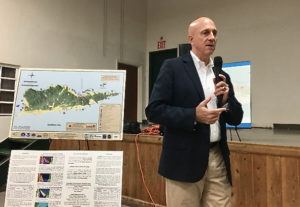
The territory’s tsunami warning sirens, destroyed by the 2017 hurricanes, should be up and running stronger than before, by September, according to Daryl Jaschen, director of the V.I. Territorial Emergency Management Agency.
Jaschen spoke Monday night during a town hall meeting at the D.C. Canegata Recreation Complex, presenting information on earthquakes and tsunamis.
He was asked several times by the audience, of around 150, when the tsunami sirens will work again. VITEMA was finalizing a contract and that the installation process would be completed in six months (by September), he said. the sirens will be replaced along the water’s edge on steel poles instead of the wooden ones, which didn’t stand up to category five storms.
Until the sirens are operational, the police department would issue tsunami warnings using bullhorns. Alert V.I., the Integrated Public Alert and Warning System as well as radio and television stations also will alert the public.
The time between an earthquake, underwater landslide, meteorite or volcano eruption and the resulting tsunami depends on the distance. A quake in the region will start to manifest within three to 10 minutes, when the water starts to recede from the shoreline and animals begin instinctively to go uphill. A distant earthquake, in Europe for instance could allow as much as three hours before a tsunami would be expected in the Virgin Islands, he said.
Usually, there are only a few minutes between the cause and the wave. When residents feel a quake or see a receding shore, they should start running uphill.
Jaschen used a tsunami evacuation map of St. Croix, available on VITEMA’s Facebook page that shows the “yellow zone.” People in the yellow zone should evacuate at the first sign of a tsunami. It is based on historical data that indicates safety can be found around 82 feet above sea level – equivalent to the top of a three-story building. The Canegata Center is about 42 feet above sea level, he said, by way of comparison.
Just as the director began his talk, a 6.5 magnitude earthquake was reported to have struck north of Honduras – the second strong quake of the day. Earlier, a 7.7 magnitude temblor was felt near Cuba. Yesterday, Ponce, Puerto Rico, had a 4 plus quake. Fortunately, none triggered a tsunami warning for the territory, but a four-inch wave was forecasted to affect the Cayman Islands.
Jaschen advised registering on the VITEMA website for Alert V.I. to receive disaster warnings as a text message, phone call or email.
VITEMA is hosting town hall meetings on all three islands because of the increased earthquake activity near Puerto Rico. Jaschen said he has investigated and dispelled rumors that human activity, such as fracking, might be causing the quakes. There is no explanation except that these islands are in quake prone areas, surrounded by the Caribbean plate, North American plate, the five-mile-deep Puerto Rican trench and the 4.4-meter-deep Anegada trough.
“That’s Mother Nature giving a wake-up call where she normally gives a wake-up call,” he said.
After showing a short video about avoiding injury during an earthquake, Jaschen said the most important takeaway is “drop, cover, hold,” while avoiding windows, mirrors and furniture. After the quake, he said to turn off the gas, turn on a radio and go outside to an open space.
“After everything, don’t go back in your home until it has been assessed,” he said.
Preparing for a disaster should include setting a meeting point for the family and a disaster kit. The designated assembly points on St. Croix are Claude O. Markoe school, St. Croix Educational Complex and the Seventh-day Adventist School. Those locations are not shelters but a place to check on the status of recovery.
Jaschen answered more than a dozen questions from the audience. Several people wanted to know how those with handicaps will escape and learned there is no public assistance. They should form support groups and rely on friends and neighbors.
“Let’s survive together and help each other out,” he said.
Other questions targeted how the V.I. Water and Power Authority’s equipment would fare in a tsunami and/or earthquake. The director admitted “it won’t be a good event,” and that utilities along the coast will pose an “environmental problem.”
Jaschen accepted gracefully the criticism that VITEMA took too long to host the town hall meeting, saying “there is no excuse.” He pointed out they have been to the schools and on radio talk shows teaching residents how to prepare for and survive disasters.
Two VITEMA town halls have been held on St. Croix. Next week, there will be events on St. Thomas at Ivanna Eudora Kean High School, Charlotte Amalie High School and the University of the Virgin Islands.





